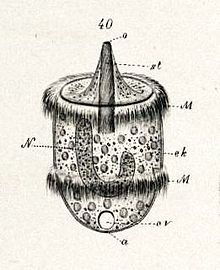Didinium
| Didinium | |
|---|---|
 |
|
| Didinium nasutum as illustrated by Schewiakoff, 2019 | |
| Scientific classification | |
| Domain: | Eukaryota |
| (unranked): | Sar |
| Phylum: | Ciliophora |
| Class: | Litostomatea |
| Order: | Haptorida |
| Family: | Didiniidae |
| Genus: |
Didinium Stein, 1859 |
Didinium is a genus of unicellular ciliates with at least ten accepted species. All are free-living carnivores. Most are found in fresh and brackish water, but three marine species are known. Their diet consists largely of Paramecium, although they will also attack and consume other ciliates. Some species, such as D. gargantua, also feed on non-ciliate protists, including dinoflagellates, cryptomonads, and green algae.
Didinia are rounded, oval or barrel-shaped and range in length from 50 to 150 micrometres. The cell body is encircled by two ciliary bands, or pectinelles. This distinguishes them from the related genus Monodinium, which have only a single band, except during cell division. The pectinelles are used to move Didinium through water by rotating the cell around its axis. At the anterior end, a cone-shaped structure protrudes, supported by a palisade of stiff microtubular rods (nematodesmata). This cone encloses the cytostome or "mouth" opening, as in other haptorian ciliates. The dimensions of this protuberance vary among the different species.
The macronucleus is long, and may be curved, horseshoe-shaped or twisted into a shape resembling a figure eight. A contractile vacuole and anal aperture are in the posterior of the cell.
Like all ciliates, Didinia reproduce asexually via binary fission, or sexually through conjugation.
...
Wikipedia
